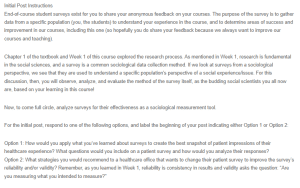Discussion – Strategies to Improve the Reliability and Validity of Patient Surveys
Suppose a healthcare office wants to change their patient survey with the aim of improving the reliability and validity of the survey, there are several strategies that I would include. The first strategy is using a pilot test or several of them on a small group that is a representative sample of all patients. Pilot tests are useful in identifying any inconsistencies in the questions as well as the performance of the survey, so that they can be addressed (Lowe, 2019). In addition, for validity, the feedback collected from these tests can be applied in revising the survey questions that do not accurately capture the information intended. Further, pilot tests improve validity because if a certain question does not yield the expected information, then it can be restructured for better results.
A second strategy to improve reliability and validity in surveys is by ensuring anonymity and confidentiality. It is important that patients feel assured that their responses are confidential which will make their answers more reliable because they feel confident in being honest without fear of exposure. Giving data while assured of their privacy ensures validity because as mentioned above, the answers are genuine (Kang & Hwang, 2023). The third strategy is making sure that the survey is inclusive. Patients in a healthcare setting will be from diverse backgrounds and as such, for the information to be reliable, it is important for the surveys to be inclusive and accessible to all. Lack of inclusiveness means that data collected will be from one or a few select groups with the exclusion of others and unless the survey was for the selected few this makes it unreliable (Kendall, 2016). Therefore, the healthcare office should ensure that their surveys take into consideration factors like cultural or linguistic background, and disabilities, among others. Lastly, the surveys should have clear and specific questions that do not lead to any misinterpretation or confusion. Patients should be able to easily understand what the surveys ask without any struggle; this way, their answers will be based on understood questions.
References
Kang, E., & Hwang, H. J. (2023). The importance of anonymity and confidentiality for conducting survey research. Journal of Research and Publication Ethics, 4(1), 1-7.
Kendall, D. (2016). Sociology in our times: The essentials. Cengage Learning.
Lowe, N. K. (2019). What is a pilot study? Journal of Obstetric, Gynecologic & Neonatal Nursing, 48(2), 117-118.
ORDER A PLAGIARISM-FREE PAPER HERE
We’ll write everything from scratch
Question 
Initial Post Instructions
End-of-course student surveys exist for you to share your anonymous feedback on your courses. The purpose of the survey is to gather data from a specific population (you, the students) to understand your experience in the course, and to determine areas of success and improvement in our courses, including this one (so hopefully you do share your feedback because we always want to improve our courses and teaching).

Discussion – Strategies to Improve the Reliability and Validity of Patient Surveys
Chapter 1 of the textbook and Week 1 of this course explored the research process. As mentioned in Week 1, research is fundamental in the social sciences, and a survey is a common sociological data collection method. If we look at surveys from a sociological perspective, we see that they are used to understand a specific population’s perspective of a social experience/issue. For this discussion, then, you will observe, analyze, and evaluate the method of the survey itself, as the budding social scientists you all now are, based on your learning in this course!
Now, to come full circle, analyze surveys for their effectiveness as a sociological measurement tool.
For the initial post, respond to one of the following options, and label the beginning of your post indicating either Option 1 or Option 2:
Option 1: How would you apply what you’ve learned about surveys to create the best snapshot of patient impressions of their healthcare experience? What questions would you include on a patient survey and how would you analyze their responses?
Option 2: What strategies you would recommend to a healthcare office that wants to change their patient survey to improve the survey’s reliability and/or validity? Remember, as you learned in Week 1, reliability is consistency in results and validity asks the question: “Are you measuring what you intended to measure?”